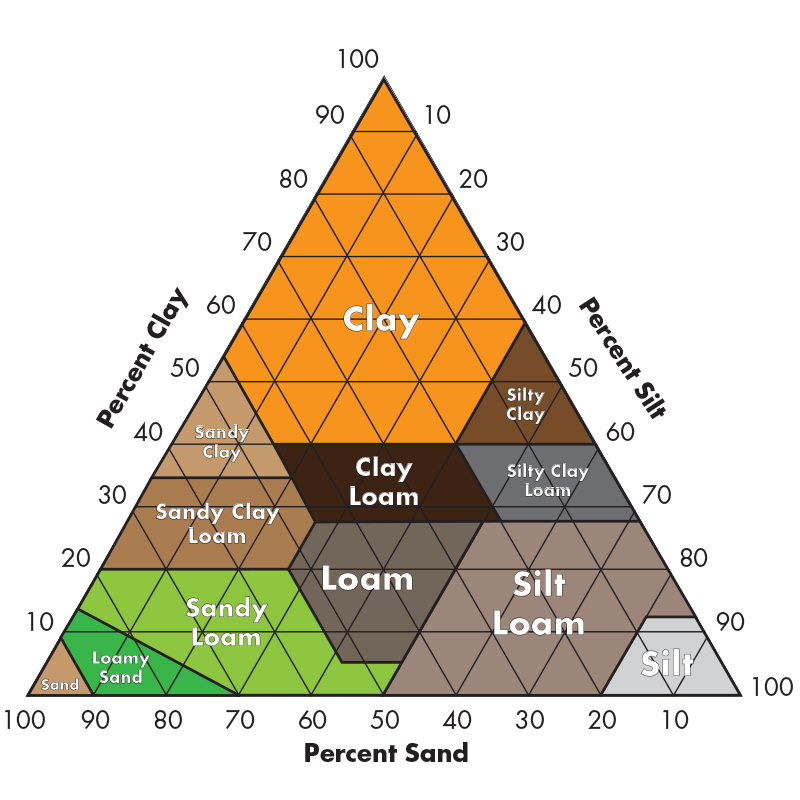
Lawn Care Tips: Get to Know Your Soil Texture
Getting the feel for lawn maintenance sometimes means digging in and getting your hands dirty. Next time you’re in the yard performing some basic lawn care, take a closer look at your soil, paying particular attention to its texture.
What Is Soil Texture?
Soil texture refers to the amount—and size—of clay, sand and silt particles in a sample of soil. It’s an important property for soil—it can tell you how much water and nutrients the soil can hold, how fast water will drain, how much air is in the soil and how deep your grass’s roots will extend. Your soil’s makeup can also give you a good idea about how your turf grass will grow by where it falls on the soil texture triangle:

How to Determine Your Yard’s Soil Texture
Although experts use a hydrometer to definitively determine soil texture, you should be able to get a good idea just by feel and sight. Sand is easily observed because it’s the largest particle in soil, whereas clay is the smallest particle and silt is in between.
Depending on the abundance and size of clay, silt and sand in your lawn, your soil texture can be described in many ways: heavy (clay), light (sandy), loamy (balanced), poor, good, fine, course, etc. So what’s the difference in terms of lawn maintenance and growing a lush lawn you can enjoy?
- Heavy soils. Heavy soils have too much clay, but they hold moisture and nutrients in the soil, making them very fertile. Unfortunately, this also makes them difficult to remoisturize after dry spells, making them poor drainage systems that require more frequent aeration than other soils.
- Light soils. Light soils have too much sand, but they breathe and drain well and are easily remoisturized after periods without rain. They also typically don’t need aeration to relieve compaction. Unfortunately, their high sand content leaves these soils with low fertility rates and an inability to hold many, if any, nutrients for long. And though they do increase root growth, light soils also dry out quickly.
What’s the Best Soil Texture for Home Lawns?
The best soil textures for home lawns are loams, loamy sands and coarse sandy loams—all are fairly well-balanced. Unfortunately, most yard soils vary in texture due to disturbances during the home’s construction.
For instance, some of your yard could be made up of soil dominated by fine-textured clay, whereas other parts could be course-textured sand. This textural discrepancy often leads to problem areas in a lawn, even with proper lawn maintenance, including:
- Dry spots
- Thin areas
- Differences in color
- Poor response to lawn treatments
- More disease or insect problems
Can You Improve Your Lawn’s Soil Texture?
The bad news is that it’s often impractical to change the soil texture for home lawns after the turf is already established. Although this is something that’s frequently done in higher-value turf grasses, such as golf courses and athletic fields, even then it’s mostly done prior to turf establishment or as part of an extensive, ongoing lawn maintenance plan.
The two most popular lawn care tips for improving home soil texture are top-dressing and aeration.
- Top-dressing. This is when you use a shovel to lightly toss ¼ to ½ of an inch of a desired element evenly across problem areas of your lawn. For instance, a heavy soil with too much clay might be top-dressed with some sand and silt.
- Aeration. Typically performed by an expert, soil aeration perforates your yard with tiny holes to allow water, air and nutrients to easily reach your lawn’s roots. Aerating your soil improves water filtration, increases air exchange, reduces compaction, intensifies overseeding establishment and boosts root growth.
Soil Structure vs. Soil Texture
Soil structure is closely related to soil texture but is concerned more with the way that soil particles are arranged and how they act as a collective when pressure is applied. Soils with good structures—not tightly compacted—allow more water and air to flow through the soil.
As pore space is reduced, soils become compacted, especially if they have a higher percentage of clay in the soil. Clay soils are generally more compacted, have lower permeability and inhibit water flow. Lawn mowers, playing children and foot traffic can also add to soil compaction, especially with wet clay soil. Adding core aeration to your lawn maintenance routine can reduce compaction and improve root growth.







